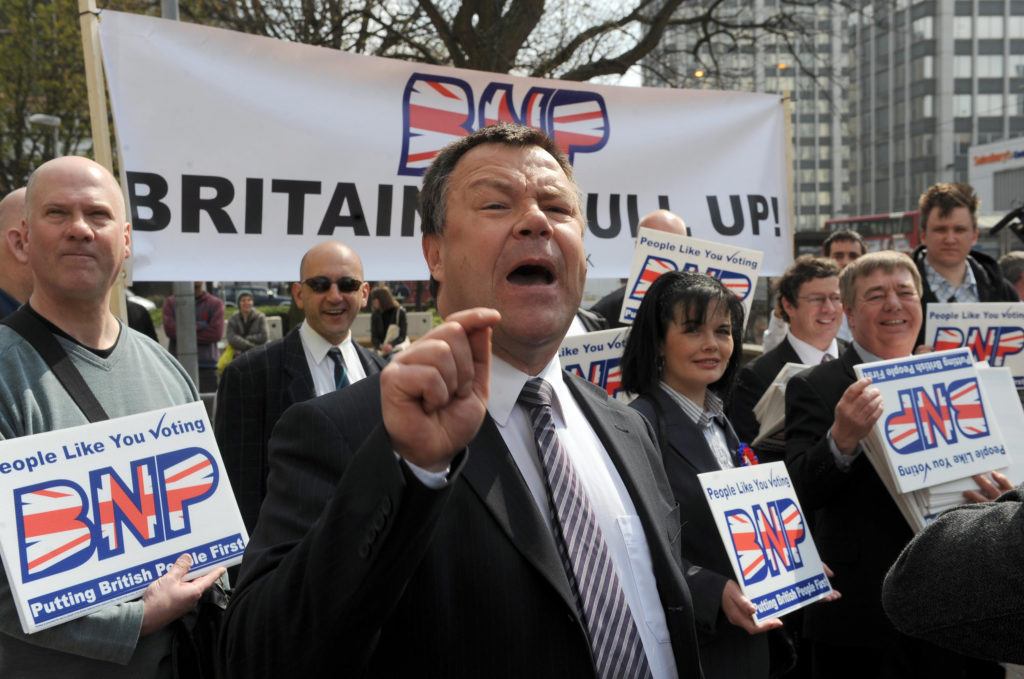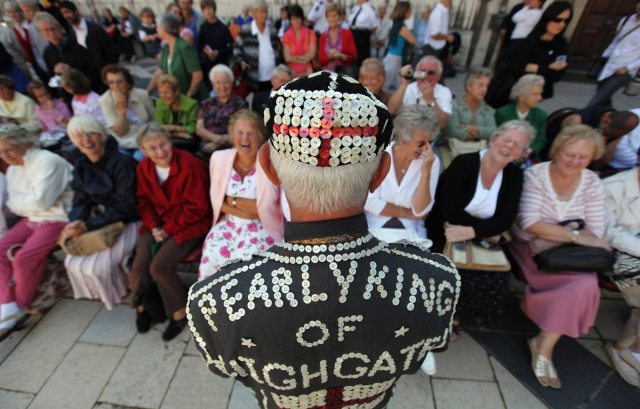The Pearly King of Highgate, descended from London’s original working-class street traders. Credit: Dan Kitwood / Getty

We all know the propaganda. London: it’s the best city on the planet. A vibrant metropolis, at ease with its diverse, tolerant self. A shining example to the world of how folk from different backgrounds and cultures can rub along together.
At least, that’s what we’re invited to believe. But the truth is that this depiction of our capital city is not one recognised by millions of its citizens. And that’s because London is, in fact, a tale of two cities.
There are the gentrified hotbeds of liberal cosmopolitanism – the Islingtons and Camdens – top heavy with the professional classes and cultural elites, the type of areas that were a bedrock of Remain support in the EU referendum.
But, then, there are those places outside the bubble. On the one hand, the grittier, traditional working-class areas – the Canning Towns and Bermondseys – populated by those steamrollered by globalisation, for whom austerity and mass immigration have exacerbated the problems of low wages, poor housing and under-pressure public services. On the other, the middle-class suburbs – the Upminsters and Eastcotes – inhabited by those who sense that their small ‘c’ conservativism is increasingly incongruous with the image of their city as a beacon of progressive modernity.
It is between these places that a new and unintended coalition has emerged, born out of resentment at having to watch their old-fashioned, socially conservative – what some describe as ‘faith, family and flag’ – views shunned and disparaged by the liberal elite. You can see something similar writ large across England: an accidental alliance between once-loyal Labour voters in the post-industrial towns and Conservatives in the shires. It’s an alliance which manifested itself most starkly in the Brexit vote.
For the Londoners that fall within these groups, their city is not the harmonious and cohesive ideal seen through the eyes of the chattering classes. It is, instead, a place that is increasingly atomised, where millions feel a diminishing sense of belonging and in which entire communities living within a few hundred yards of each other live utterly parallel lives.
Take, for example, the borough in which I grew up, Barking and Dagenham. As working-class as it gets, it was once the very exemplar of a traditional Labour heartland. Never affluent, but stable, close-knit and settled. Centred around a sprawling 1930s council estate and with generally healthy levels of employment – the dominant Ford factory being at the heart of local industry – Barking and Dagenham enjoyed its steady constancy, its social and cultural homogeneity. For those short on money and opportunity, the concepts of place, belonging, identity and relationships take on so much more meaning.
But then things changed. Over a few very short years, around the turn of the century, there was a sizeable influx of migrants, precipitating rapid social and cultural transformation. The demographic convulsions meant that stable, settled Barking and Dagenham suddenly found itself in the eye of the storm of the debate over mass immigration.
The indigenous population cried out for respite. The letters page of the local paper was filled with correspondents begging to be heard. But nobody in power took a blind bit of notice, other than to patronise them with trite arguments about improved GDP and cultural enrichment.
Rather than rally to their support, the Left – including, shamefully, the Labour party and trade unions – treated these marginalised working-class folk like an embarrassing elderly relative, imploring them to “stop blaming migrants” (something they hadn’t done in the first place). What was genuine bewilderment and disorientation on the part of local citizens was, inexcusably, dismissed as casual racism and bigotry. Yet it wasn’t their sense of race that had been violated by the sudden upheaval in their community; it was their sense of order.
So, in 2006, locals took the only route of protest they thought left available to them and returned 12 British National Party (BNP) councillors at the local elections. The noxious far-right, which previously had never gained a foothold in the borough (though had penetrated areas close by) now formed the official opposition on Barking and Dagenham council, not because thousands of locals had overnight turned into vile racists, but because they had repeatedly been ignored by a tin-eared establishment.

But even then, nothing changed. Locals were told to get with the zeitgeist. Women in their eighties who had lived in the borough for most of their lives, had raised their families there, and in many cases now lived a life of lonely isolation, were told to embrace the vibrancy of the new multiculturalism. That was the level of condescension to which the liberal establishment had sunk.
So thousands of people simply upped sticks and left. In the first decade of the new century, Barking and Dagenham experienced a vast exodus of families who had been rooted in its streets, workplaces and local institutions for generations. It was the only home that many had ever known, but they went all the same. They departed for the Essex coast or Kent. It wasn’t ‘white flight’, for skin colour was irrelevant to most of them. It was, instead, a flight to familiarity.
The tragedy was that most of these people never were – still aren’t – anti-immigration. Being fundamentally decent and fair-minded citizens, they would not have objected to the integration of a modest and manageable number of arrivals over a reasonable period of time. But the whole debate around immigration has been toxified by what the ruling elites imposed on places such as Barking and Dagenham. They shook a kaleidoscope and then stood back in surprise when the pieces didn’t fall exactly where they wanted.
Remember all this the next time you hear someone speak of London as the greatest city in the world. Chances are the words are being spoken by a politician or a celebrity or a middle-class liberal from one of the trendier parts of town.
For there are, in reality, two Londons out there. One half of it – alienated, neglected and resentful – represents a potentially formidable army at the ballot box. Who will speak for it?










Join the discussion
Join like minded readers that support our journalism by becoming a paid subscriber
To join the discussion in the comments, become a paid subscriber.
Join like minded readers that support our journalism, read unlimited articles and enjoy other subscriber-only benefits.
Subscribe